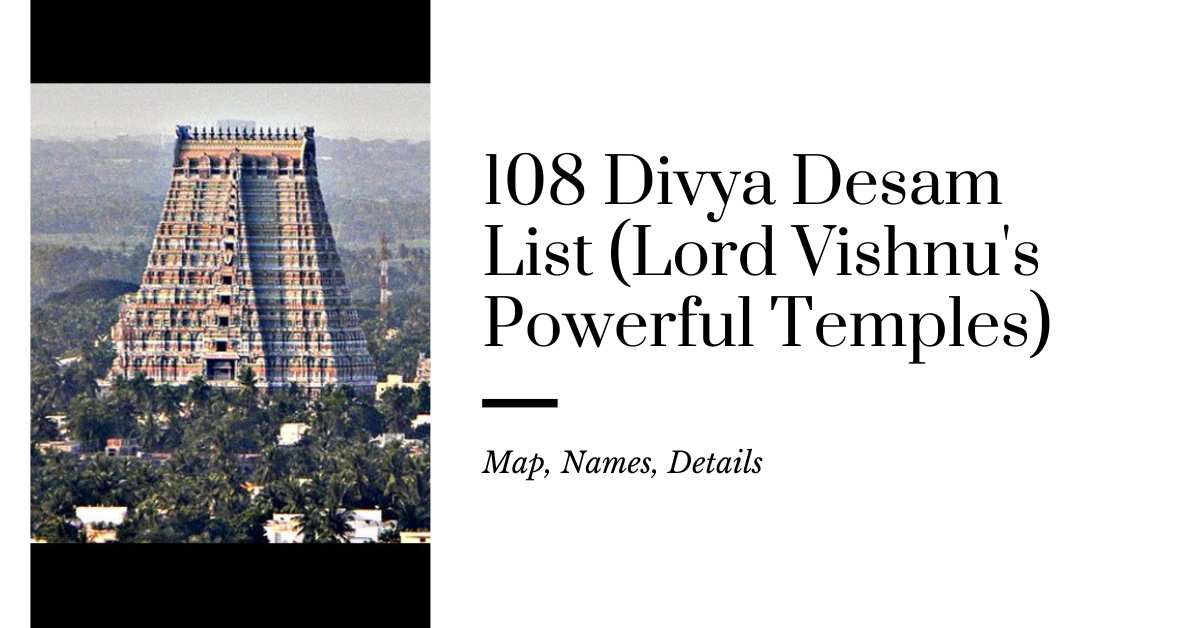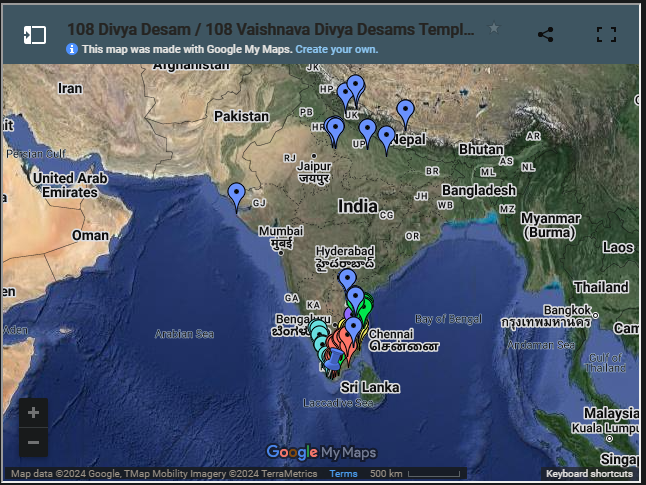The 108 Divya Desam, or the 108 Divine Abodes, are a sacred group of 108 Vishnu temples revered in the Hindu tradition. These hallowed shrines, scattered across the Indian subcontinent, are believed to be the earthly manifestations of Lord Vishnu, the preserver and protector of the universe. For those interested in exploring these sacred sites, the 108 Divya Desam list provides a comprehensive guide to each temple’s location and significance.
Each of these temples holds a unique and profound significance, embodying the essence of the divine and serving as sanctuaries for spiritual enlightenment. Embarking on a pilgrimage to these sacred sites is considered a profoundly transformative experience, one that promises to uplift the soul and forge an unbreakable bond with the Divine.
108 Divya Desam List: Origins and Importance
The concept of the 108 Divya Desam finds its roots in the Alvars, a group of 12 revered saints who lived between the 6th and 9th centuries CE. These mystic poets and devotees of Lord Vishnu composed thousands of devotional hymns, known as the Nalayira Divya Prabandham, which extolled the glory and divinity of the Lord’s abodes.
According to legend, Lord Vishnu himself revealed these 108 sacred sites to the Alvars, granting them the privilege of spreading the eternal wisdom and enlightenment found within these hallowed grounds. Each temple in the 108 Divya Desam is believed to house a specific manifestation of Lord Vishnu, each with its unique iconography, legends, and spiritual significance.
108 Divya Desam List: Pilgrimage & Spiritual Significance
Embarking on a pilgrimage to the 108 Divya Desam is considered one of the most profound spiritual journeys in the Hindu tradition. It is a quest that transcends physical boundaries, inviting devotees to immerse themselves in the divine essence and seek the ultimate truth.
The journey itself is a metaphor for the human soul’s journey towards enlightenment, with each temple representing a stepping stone towards spiritual awakening. As pilgrims traverse these sacred sites, they engage in rituals, prayers, and meditation, seeking to purify their minds and forge a deeper connection with the Divine.
The 108 Divya Desam are scattered across various regions of India, with a significant concentration in the states of Tamil Nadu, Kerala, and Andhra Pradesh. Some of the most renowned temples within this sacred network include:
- Sri Ranganathaswamy Temple, Srirangam: One of the most revered and largest functioning Hindu temples in the world, this grand complex is dedicated to Lord Ranganatha, a reclining form of Lord Vishnu.
- Srivilliputhur Divya Desam: This ancient temple, located in Tamil Nadu, is believed to be the birthplace of the revered saint Manavala Mamunigal and is renowned for its intricate architecture and spiritual aura.
- Venkateswara Temple, Tirumala: Situated atop the sacred Venkata Hill in Andhra Pradesh, this temple is one of the most visited Hindu shrines in the world, attracting millions of pilgrims annually.
- Srirangam Ranganathaswamy Temple: This vast temple complex in Tamil Nadu is renowned for its massive compound, which is said to be the largest functioning Hindu temple in the world.
- Guruvayur Sri Krishna Temple: Located in Kerala, this stunning temple is dedicated to Lord Krishna and is renowned for its intricate architecture, rich traditions, and spiritual ambiance.
Each of these temples offers a unique and profound spiritual experience, with their own legends, rituals, and architectural marvels that inspire awe and reverence in the hearts of devotees.
What is 108 Divya Desam List?
The 108 Divya Desam Temples span various regions of India and include one temple located in Nepal. These sacred sites are categorized based on their geographical locations, encompassing.
The Divya Desam Temples are 108 special temples dedicated to Lord Vishnu, as described by the Tamil Azhvars, who were holy saints. “Divya” means “special” and “Desam” means “place” or “temple.” Out of these temples, 105 are in India, one is in Nepal, and two are in otherworldly realms: Thirupalkaddal, symbolizing the ocean of milk, and Paramapadam, representing Srivaikuntam, the heavenly abode of Lord Narayana.
These temples are important and are praised in the Divya Prabandha, which is a collection of 4,000 Tamil verses written by 12 Azhvars. While most of these temples follow the Thenkalai way of worship, some follow Vadakalai and other traditions.
The temples are divided into seven groups based on where they are located:
- Thondai Naadu Temples
- Chozha Naadu Temples
- Nadu Naadu Temples
- Pandiya Naadu Temples
- Malayala Naadu Temples
- Vadu Naadu Temples
- Vinnulaga Thiruppathigal
Inside these temples, the statues of Lord Vishnu are in three main positions:
- Sleeping Position – In 27 temples
- Sitting Position – In 21 temples
- Standing Position – In 60 temples
Additionally, the direction in which Lord Vishnu faces varies in these temples:
- Facing East – In 79 temples
- Facing West – In 19 temples
- Facing North – In 3 temples
- Facing South – In 7 temples
108 Divya Desam List State Wise
The traditional count of Divya Desam temples is 108, symbolizing completeness and spiritual fulfillment in Hinduism. However, in reality, there are more than 108 temples recognized as Divya Desams due to various interpretations, regional beliefs, and historical developments.
Tamil Nadu (84 Divya Desam List)
- Srirangam
- Tiruchirappalli (Tirukkudanthai, Tirukkozhi)
- Kanchipuram (Varadharaja Perumal, Ashtabhujam, etc.)
- Tiruvallur (Veeraraghava Perumal)
- Srivilliputhur (Vada Perunkovil)
- Alagarkoil (Koodal Azhagar)
- Thanjavur (Oppliyappan, Nachiyar Koil)
- Tirunelveli (Tirukurungudi, Tirukkolur)
- Kumbakonam (Tirukkannapuram, Kapisthalam)
- Mayiladuthurai (Tirukkannangudi, Tirunagari)
- Thoothukudi (Tirupper Nagar, Vaikuntha Vinnagaram)
- Nagapattinam (Tirukkannamangai)
- Ramanathapuram (Tirupullani)
- Virudhunagar (Tiruthangal)
- Madurai (Tirumogur, Koodal Azhagar)
- Devapiran (Tirupathi)
- Sthala Sayana Perumal (Mahabalipuram)
- Parameswara Vinnagaram (Kanchipuram)
- Tiruvahindrapuram (Cuddalore)
- Tirukannapuram
- Tirukannamangai
- Tirupullabhoothangudi
- Tiruarimeya Vinnagaram
- Tirunavari (Tirunangur)
- Tirumeyyam
- Tirukovilur
- Tirumala (Tirupati)
- Tirumogur
- Tiruchitrakoodam
- Tirupper Nagar (Srirangam)
- Tirukkurungudi
- Tirukannangudi
- Tiruvellarai
- Tirukkachhi
- Tirukachi Nambi (Madurantakam)
- Tiruneermalai
- Tirukkannapuram
- Tirukannamangai
- Tirupullabhoothangudi
- Tiruarimeya Vinnagaram
- Tirunavari (Tirunangur)
- Tirumeyyam
- Tirukovilur
- Tirumala (Tirupati)
- Tirumogur
- Tiruchitrakoodam
- Tirupper Nagar (Srirangam)
- Tirukkurungudi
- Tirukannangudi
- Tiruvellarai
- Tirukkachhi
- Tirukachi Nambi (Madurantakam)
- Tiruneermalai
- Tiruthankaal
- Tiruththolaivillimangalam (Erattai Tiruppathi)
- Tiruttavatturai (Tirupperai)
- Tiruvananthapuram (Ananthapadmanabhaswamy)
- Tiruvattar (Adikesava Perumal)
- Tiruvanparisaram
- Tirukkuralappan (Thirukurungudi)
- Tirukuralappan (Tirunelveli)
- Tirukkadalmallai (Mahabalipuram)
- Tirukalukundram
- Tirukalukundram
- Tiruvallur (Thiruvallur)
- Tirukottiyur
- Tirukoshtiyur (Tirukoshtiyur)
- Tirumangai
- Tirumangaivalli
- Tirupathur
- Tirupati (Alagarkoyil)
- Tirukkachchi (Kanchipuram)
- Tiruneermalai (Pallavaram)
- Tirutholaivillimangalam
- Tiruvanparisaram (Tiruvanparisaram)
- Tiruvattar (Adikesava Perumal)
- Tiruvanparisaram (Tiruvanparisaram)
- Tiruvattar (Adikesava Perumal)
- Tiruvanparisaram (Tiruvanparisaram)
- Tiruvattar (Adikesava Perumal)
- Tiruvanparisaram (Tiruvanparisaram)
- Tiruvattar (Adikesava Perumal)
- Tiruvanparisaram (Tiruvanparisaram)
- Tiruvattar (Adikesava Perumal)
Kerala (13 Divya Desam List)
- Thiruvananthapuram (Anantha Padmanabhaswamy)
- Thiruvalla (Vallabha Perumal)
- Chenganur (Puliyur Mahavishnu)
- Kozhikode (Tirunavaya)
- Alappuzha (Ambalapuzha)
- Thrissur (Guruvayur)
- Palakkad (Thiruvithuvakodu)
- Ernakulam (Thirukaatkarai)
- Tiruvalla
- Tiruvalla (Vallabha Perumal)
- Chenganur (Puliyur Mahavishnu)
- Kozhikode (Tirunavaya)
- Alappuzha (Ambalapuzha)
Andhra Pradesh (2 Divya Desam List)
- Tirupati (Venkateswara)
- Ahobilam (Narasimha)
Uttar Pradesh (4 Divya Desam List)
- Mathura (Govindaraja)
- Vrindavan (Rangaji)
- Ayodhya (Chakravarti Thirumagan)
- Varanasi (Vishnu)
Uttarakhand (3 Divya Desam List)
- Badrinath (Badrinarayana)
- Joshimath (Narasimha)
- Haridwar (Rishikesh – Tirukkandam)
Gujarat (1 Divya Desam)
- Dwarka (Dwarkadhish)
Madhya Pradesh (1 Divya Desam)
- Ujjain (Govindaraja)
Rajasthan (1 Divya Desam)
- Jaipur (Govindaraja)
Nepal (1 Divya Desam)
- Kathmandu (Muktinath)
Vinnulagam (Outside the Earthly Realm Divya Desam List):
- Thirupalkkadal
- Paramapadam
Read More: वीर हनुमाना भजन के बोल (Veer Hanumana Lyrics): शक्ति का संगम
Frequently Asked Questions (FAQs) about 108 Divya Desam List
1. Why should we visit 108 Divya Desams?
Embarking on a pilgrimage to the 108 Divya Desams is not merely a physical journey but a spiritual odyssey that offers multifaceted benefits to devotees. Here are compelling reasons to undertake this sacred sojourn:
- Spiritual Awakening: Visiting these divine abodes allows devotees to immerse themselves in the spiritual ambiance, fostering inner peace and spiritual rejuvenation.
- Divine Blessings: Seeking the blessings of Lord Vishnu at these sacred sites is believed to bestow divine grace, protection, and auspiciousness upon devotees and their families.
- Cultural Richness: The 108 Divya Desams steep in rich cultural and architectural heritage, offering visitors a glimpse into ancient Hindu traditions and architectural marvels.
- Pilgrim Camaraderie: Pilgrims foster a sense of camaraderie among fellow devotees while journeying to these sacred shrines, creating an atmosphere of shared devotion and spiritual unity.
- Karma Cleansing: Visiting these holy sites and participating in rituals is believed to cleanse one’s sins and karmic burdens, paving the way for spiritual evolution.
2. Is Tirupati part of the 108 Divya Desam List?
Yes, Tirupati is part of the 108 Divya Desam list. It is one of the sacred Vishnu temples recognized in this list. Specifically, the temple at Tirupati is dedicated to Lord Venkateswara.
3. How many Divya Desams are there on Earth?
According to Hindu tradition, devotees revere 108 Divya Desams (2 in heaven) spread across the Indian subcontinent for their association with Lord Vishnu and the divine manifestations recounted in ancient scriptures and hymns.
4. Which is the second Divya Desam?
The second Divya Desam is Tirupati (Venkateswara Temple).
5. Which is 107th Divya Desam?
The 107th Divya Desam is Paramapadam (Vaikuntha), which is a celestial abode and not located on Earth.
6. Is Ayodhya a Divya Desam?
Yes, Ayodhya is a Divya Desam.
7. Why is Chidambaram temple secret?
The Chidambaram temple is famous for its Chidambara Rahasya (the secret of Chidambaram), which symbolizes the formless nature of the divine.
8. Which God is Chidambaram?
The Chidambaram temple is dedicated to Lord Nataraja (Shiva).
9. Why is it called Divya Desam?
These temples are called Divya Desams because they are praised in the Divya Prabandham, the early medieval Tamil canon of the Azhwar saints from the 6th–9th centuries AD.
10. Is Tirumala a Divya Desam?
Yes, Tirumala is a Divya Desam, specifically the temple of Lord Venkateswara.
11. How many Divya Desams are there in Srirangam?
There is one Divya Desam in Srirangam: Sri Ranganathaswamy Temple.
12. How many Divya Desam are there in Kanchi?
There are 14 Divya Desams in Kanchipuram.
13. How many Divya Desams are there in Kerala?
There are 13 Divya Desams in Kerala.
14. How many Divya Desams are there in Chennai?
There are 2 Divya Desams in Chennai: Parthasarathy Temple and Tiruneermalai.
15. How many Divya Desams are there in North India?
There are 11 Divya Desams in North India.
16. How many Divya Desams are there in Kanchi?
There are 14 Divya Desams in Kanchipuram.
References for 108 Divya Desam List Blog
- Ranganathaswamy Temple, Srirangam – Wikipedia
- Divya Desam: Thiruvarangam Temple
- TempleNet: Thiruvarangam Temple
- Tamil Nadu Tourism: Alwarthirunagari Perumal Temple
- 108 Divya Desam List Wiki


4 thoughts on “108 Divya Desam List – Map, Names, Details”